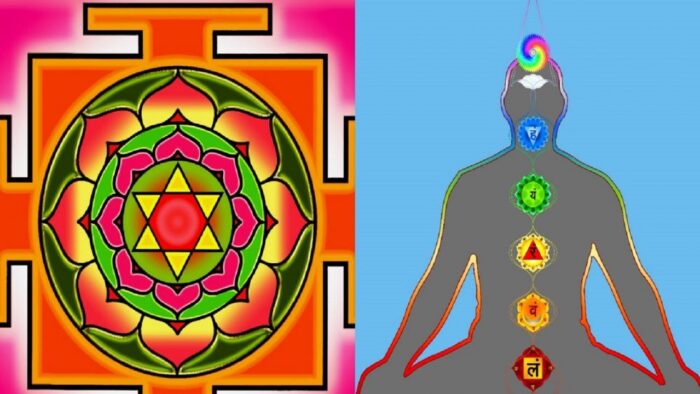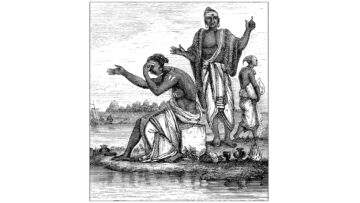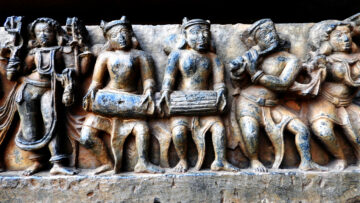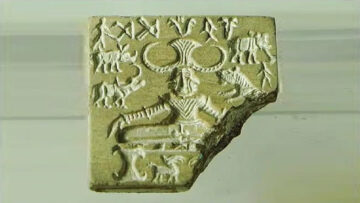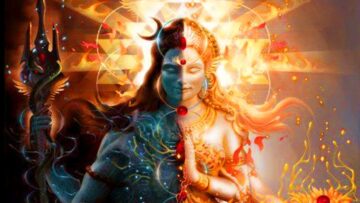Abstract
By applying the contemporary theories of schema, metonymy, metaphor, and conceptual blending, I argue in this paper that salient cognitive categories facilitate a deeper analysis of Tantric language. Tantras use a wide range of symbolic language expressed in terms of mantric speech and visual maṇḍalas, and Tantric texts relate the process of deciphering meaning with the surge of mystical experience. In this essay, I will focus on some distinctive varieties of Tantric language with a conviction that select cognitive tools facilitate coherent reading of these expressions. Mystical language broadly utilizes images and metaphors. Deciphering Tantric language should therefore also provide a framework for reading other varieties of mystical expressions across cultures.
1. Introduction to the Categories
This essay explores an interface between the domains of cognitive linguistics and Tantric traditions. The specific concepts I have borrowed from the field of cognitive studies involve the concepts of schema, metonymy, and metaphor, and the theory of cognitive blending. The objective is to decipher Tantric language, both its visual and speech expressions, with the aid of the basic cognitive devices. I am using Tantra very broadly here, as any text or practice that shares some of the common elements of Tantra, such as mantra, maṇḍala, visualization, or an installation of the syllables (nyāsa) fall under this category. Those interested in defining Tantra can consult White ([1], p. 9). Tantric texts and practices focus on transforming experience from commonsense to mystical, although the category of “mystical” needs to be read as translating Tantric esoteric experiences. Unfortunately, “mystical” itself is a loose category. Contemporary scholarship has a substantial amount of conversation regarding this category, including the cognitive approach to comprehend what has been culturally identified as mystical [2–6]. Broadly, any alternate state of experience, hazy consciousness, experiences that involve the sacred, experience of pure consciousness or luminosity, along with the literary texts and devices that relate to these experiences either to capture, hone, rectify, or elaborate upon these experiences relate to the domain of the mystical, and any discipline that comes out of this conversation or the experiences that are institutionalized through these conversations fall under the domain of mysticisṃ Most cultures share something that paves the path to an alternate state of experience and most cultures assign this experience as relating to the sacred. In general, Tantric language can be considered a subset of mystical language, and the approach of reading archaic forms of expression, common to Tantric tradition, can pave the path of reading any other mystical literature. Most Tantras address some esoteric states of experience and provide a pathway to acquire these experiences by means of visualizing various geometric designs called maṇḍalas, or by articulating or visualizing the phonemes that possess assigned additional power exceeding the mere semantic power of references called mantras, or by activating both the domains of sound and vision through the practice of mantra and maṇḍala simultaneously. This is exactly where the subset of mystical language, the language of images, and phonemes with extra-semantic power come into play. In this essay, I will focus on some distinctive varieties of Tantric language with a conviction that select cognitive tools facilitate coherent reading of these expressions. Mystical language broadly utilizes images and metaphors. Deciphering Tantric language should therefore also provide a framework for reading other varieties of mystical expressions across cultures.
The approach of reading Tantric literature through the lens of cognitive science is not new. My own studies have been greatly inspired by the works of Glen Alexander Hayes. Hayes [7] addresses schemas in light of Tantric sādhanā with a focus on Vaisnava Sahajiya texts, while my own focus lies on classical Sanskrit texts on the tradition of Śrīvidyā and Kālī traditions. With the same focus on Vaisnava Sahajīyā and Tantric literature, Hayes has sought to unravel the mystical language in light of contemporary metaphor theory [8–10]. I have found this work insightful, not only to read classical Tantric texts, but also to decompress meaning that lies beneath mantric language and to unravel the metaphoric language of Tantric visualization. Among the cognitive tools, metonymy is slowly gaining in prominence, as this device appears to be even more universal than thinking through metaphors, and keeping this in mind, I have explored the metonymic domain of Tantric language. Hayes has also explored the theory of cognitive blending in order to shed light in mystical Tantric language [11]. While utilizing these concepts from cognitive theory, my own approach here is to identify metonymic and metaphoric structures in classical Tantric literature, and in particular, to engage the visual domain of Tantric language. In practice, Tantric culture is highly visual, with images at the center of everyday visualization. Both the public and private domains of Tantric life involve sequences of meticulous visualization and animation or bringing the imagery to life. Tantric language has proven enigmatic, and the scholars who have attempted to analyze Tantric language by a literal translation have done a great disservice to Tantra itself, as this approach violates the intent of both the texts and the tradition. By engaging cognitive devices in order to unravel the suggested meaning layered within Tantric symbolism, my expectation is to correct some of the grotesque misrepresentations of Tantric mystical language. This is by no means to reject the relevance of other approaches. I just simply fail to comprehend how, by understanding the practice of some esoteric circles sharing their mystical experience among select followers, can be generalized to make broad social claims. There was a time when people like Abbe Dubois could enchant the Western audience with the narratives of faraway lands. The social claims made, based on those who were outcasts by choice, the Tantric esoteric circles, can hardly shed light on those who are socially marginalized. This epistemic quagmire has led some of my colleagues to return to old school philology, as if reading the original texts in their original context can actually give us deeper insights. Tantric texts are opaque and can easily mislead even the adepts, forget about the Western audience that lacks social sensitivity and is unaware of linguistic and philosophical complexity. Moreover, this tendency fails to address the value of such endeavors: whatever efforts at interpretation are made bear no consequence for us, individually or collectively; those endeavors are meaningless and it is wise not to pursue those efforts, just like a buffoon striking water to inflict pain (jalatād.ananyāya). On the other hand, reading Tantric literature by applying cognitive theories has a meaningful role to play. This helps us use some devices that possess the methodology to unravel the layered meaning nesting beneath opaque practices and mystical texts. Moreover, this helps to globalize Tantric studies. Simply put, if there is anything valuable in these texts and traditions and if Tantric practices can serve humanity, the whole world deserves the benefits of such practices. In addition, if these claims are false, the world also deserves to make counter-arguments. My own efforts rest on the assumption that these texts and traditions have a wealth of materials to add to a meaningful global conversation.
Please allow me to introduce some of the categories essential to further our conversation. First, the schema. Schema is a mental framework, a way of organizing knowledge, a map for us to evaluate the situation and guide response. We anticipate a certain sequence of events in certain rituals, or expect someone to behave in a particular way. We respond to situations based on our own internalized frameworks or what we believe we are. Following Piaget [12], schema is “a cohesive, repeatable action sequence possessing component actions that are tightly interconnected and governed by a core meaning”. George Lakoff and Mark Johnson have advanced some of the arguments in the study of schemas [13,14]. Pertinent among them is the concept of “image schema” which stands for the structure of our cognitive process that helps us establish patterns of understanding and reasoning [15]. Broadly, image schema is a prelinguistic structure of experience that guides the process of mapping over domains in forming conceptual metaphors. There are three distinctive ways that the recognition of schemas helps us understand Tantric language: (i) Tantric images anticipate a particular narrative with defined roles given for the specific deities, and assigning meaning by use of conceptual metaphors and their decompression is possible as we recognize the schemas and how they operate as placeholders. When we see the image of Durgā, we see a goddess slaying a buffalo-demon. The narrative, found in the Devīmāhātmya, provides substance to the image by recounting the victory of the goddess over Mahis.āsura. In some contexts, the texts themselves are visualized as images. The Bhagavadgītā or the Prajñāpāramitā are actual texts. Nevertheless, these are also visualized in some deity forms. By identifying the textual relation to the imagery, the viewer can make sense of what constitutes specific aspects of the imagery. Narratives with graphic and complex imagery, such as that of the blended image of Hari-Hara, where the deity image depicts Half Śiva and half Vis.n.u, or the image of Ardhanārīśvara, where Śiva and Śakti blend in a single body and constitute an imagery by borrowing aspects from both, are inconceivable without knowing the narratives that underlie these images; (ii) Tantric texts choose to remain obscure and intentionally use abstract metaphors. Recognizing their schematic patterns and textual interrelations helps us unravel the source of the metaphors. The same applies to other cognitive processes such as metonymic thinking or conceptual integration or blend. Cidgaganacandrikā, the text that I borrow examples from in this essay in the following pages, for instance, is inconceivable without the knowledge of the specific system, the mantras, deities, and maṇḍalas, associated with Kālī of the northern transmission. Tantric texts almost always use substitute words for each of the phonemes, and one unaware of the meticulous process of deciphering the mantras is out of luck to make sense of these opaque group of words; (iii) Above all, recognizing the schema in Tantric language allows us to make a meaningful conversation about the altered states of consciousness that are mapped in bodily language and the mystical and esoteric experiences are described in terms of orgasmic or other forms of somatic experiences. This is vivid in the discourse on the surge of Kuṇḍalinī. Top-down metaphors classify the surging experiences and map them in the language of a physical journey of the serpentine force. The flow of prān.a is expressed in the language of the blossoming and closing of the lotus petals. Moreover, the divine body is mapped onto the body of the aspirant, and this in turn is transformed into some geometric designs and phonetic configurations. Deities portray graphic emotions, mostly of rage and lust. Transformed and altered experiences, in these systems, are mapped within the body, and some insights from the contemporary discourse on body schema further ground this esoteric discourse. This goes without saying now that engaging cognitive linguistic devices in unraveling the Tantric esoteric language does not reduce Tantra or its experiences, but only aids in a common sense understanding of this otherwise opaque discourse.
Schemas help us understand metonymy and metaphors, two of the prominent cognitive categories that the Tantric exegetes applied in advancing their semiotics. Although the role of metaphor has been recognized since the ancient times, Lakoff and Johnson [16] have made it clear that these structures are some of the most prominent among our cognitive mechanisms that help us relate or “map” one concept with another and are thus fundamental to conceptualization itself. As Hayes [7] has pointed out, understanding body schemas allows us to map Tantric mystical language. For a broader conversation on body schema, Shaun Gallagher [17] has made some insightful arguments. In my own reading, body schemas construct and apply to both Tantric cosmology and visualization. Even the Tantric ritual of installing the seed syllables in the body called nyāsa rests on mapping cosmic planes within the body and recognizing Tantric principles in relation to the body schemas. The Nyāsa rituals generally involve invoking some phonemes and touching the limbs of the body, metaphorically installing them within the aspirant’s body. In this ritual process, these phonemes are mapped with the body of the deity and function as the device to transform aspirant’s body into the divine one. A transformed or altered state of experience is the anticipated result of this installation ritual. The most common nyāsa ritual involves installing the syllables in five fingers and the palm, and select corporeal limbs such as heart, head, tuft (śikhā), chest, eyes and the surrounding area. Deity mantras are generally broken into five parts, and the collective mantra and those five parts are distributed accordingly throughout the body of the aspirant in order to “make” one’s body divine.
In metonymic thinking, certain acts are represented instead of the person doing the act, the place for the event, and so on. By means of this mechanism, some subcategories or members or sub-models stand for the entire category and can be used to comprehend the category as a whole [15]. This something (A) standing for something else (B), as Lakoff and Johnson [18] have pointed out, is one of the most common cognitive traits that facilitate the organization of our thoughts, and is common across cultures. When something (A) stands for something else (B), A is identified as the source and B as the target. To reiterate, metonymy is a conceptual mapping within a domain that involves a “stands-for” relationship between the source and target domains and is used primarily for reference ([19], p. 103)1 . Readers may find Patton’s [21] conversation on Sanskrit and Vedas also relevant for understanding this philosophical discourse on metonymy.
Broadly speaking, metaphor is based on similarity whereas metonymy relies on contiguity, and metaphor offers alternative conceptualizations for the same phenomenon while metonymy links phenomena to each otheṛ The difference between metonymy and metaphor is maintained on the ground that metonymy is a single domain mechanism whereas metaphor relies on two distinct source and target domains. In metaphor, we can have multiple mappings between two domains, whereas in the case of metonymy, we can have only one relation. In metaphor, the relation is “target is source,” whereas metonymy can be characterized as “source for target”. Following the structuralists, metaphor is associated with the principles of selection and substitution, whereas metonymy is linked with the principles of combination and contexture [22]. Conventional metaphors and metonymies reveal an automatic connection between two conceptual structures. The metaphors and metonymies that are commonly grasped and expressed in communication are often particular manifestations of a more abstract superordinate metaphor and metonymy that are, to a large extent, culturally-specific and “contingent” in that the source and target relation is not necessary ([23], pp. 64–96).
A literal reading of the Visual Tantra leads nowhere. The goddess Lakṣmī carries a snake, a phallus, and a vagina on her crown. Goddess Guhyakālī carries ten Mahāvidyā deities in her arms as ten weapons. Kāli sits atop Mahākāla, the Lord of time and death. Kāmakalā dances atop a crescent moon. Many gods come with one thousand arms, with each carrying specific weapons and displaying particular gestures. Most deities have three eyes, while others come with multiple heads. To make it even more perplexing, each of the heads is associated with a different deity. In contrast to these perplexities, when we apply the framework of metonymy and metaphor, a fluid transaction among ritual, text, and imagery occurs, and the images express what has been institutionally retained behind the articulated language. For the purpose of applying the devices of metonymy and metaphor, I am using the generally outlined parameters of metonymy and metaphor, where metaphors are used for substitution and metonymy for association; metaphors act by suppressing ideas whereas metonymy acts by combining ideas; in metaphor, comparison is based on similarity whereas in metonymy comparison is based on contiguity. “He is a tiger” is a metaphoric use; “I am being trained by a tiger” is a metonymic application. The same weapons and gestures can be used as metaphors or metonymies at different times, and only the texts and the rituals can determine the actual scope of its application. Where the texts portray Durgā riding a tiger, the tiger expresses valor, and the corpse that Cāmuṇḍā rides represent death. When transformed into visual language, there is no longer a corpse standing for something else, as an actual corpse is depicted in the imagery. All the artistic expressions borrow nuances of metaphor and metonymy. The only addition in Tantric visualization is that there is a ritual(1) practice and textual tradition as the foundation. This gives the much-needed boundary to deciphering the visual language.
One additional category from the cognitive domain is the concept of blending. Fauconnier and Turner have championed the theory of “conceptual blending” as a general theory of cognition, following which we are cognitively wired to blend ideas from different domains to construct new concepts and this process is common to all the domains of human cognition. In metonymic thinking, something A has a surplus of meaning. In metaphoric thinking, the significance of something from source A is projected onto something else, B. In the case of conceptual blending, select aspects are borrowed from both domains and projected onto an emergent structure, a blend. For a reader new to this application, Turner’s The Origin of Ideas [24] is a good text that explicates the concept of blending. In this text, Turner makes some far-reaching arguments that are pivotal to understand some of the key conversations in this papeṛ For example, Turner says that our ability to develop and use new ideas comes from our ability to blend or integrate the pre-existing existing ideas [2,24]; blending is a universal cognitive phenomenon [3,24]; this blending of different ideas into one happens in the mental space [4,5,24]; we compress ideas to think about larger mental webs [9,24]; or imagination is an essential cognitive mechanism for blending [17,18,24]. While the concept of “blend” is unique to these cognitive linguists, this framework finds precedent in classical Sanskrit philosophy and the classical discourse on literary tropes, and the designative power of language helps us bridge the two domains of classical Sanskrit philosophy and modern cognitive linguistics. While Turner uses examples such as “I am a tiger” [12,24] or “lion-man” [13,24] to demonstrate what a “blend” is, these same examples appear in the aesthetic context of Sanskrit texts, for example, “siṃ ho mān.avakah.” or “narasiṃ ha”, and I see no reason that precludes a global approach to discuss these identical issues.
I am not alone in making this argument [25]. What is unique to understanding Tantric visual language, though, is the application of these concepts to unraveling the significance of blended images, such as that of Narasiṃ ha. In addition, this is just one experiment. The scope of this approach is not reserved to Tantric language alone. Whether we are interested in understanding Egyptian blended imagery or Aztec visual culture, whether our approach is to understand the blended images from China or from Africa, conceptual blending is an essential tool to excavate the meaning embedded within these images. Some of my colleagues have expressed that I must be maintaining the most radical form of reductionism in order to apply the framework of blending. I beg to diffeṛ Classical Sanskrit literature has abundant discourse on abhihitānvaya or syntactic reductionism and anvitābhidhāna or syntactic holism, and neither of these positions led these philosophers to surrender to absolute reductionisṃ I would have to deviate from the main discourse, if I were to shape the trajectory of this discourse about the possibility of applying the concept of “blend” without maintaining radical materialism.
Moving back to our original thread, I have pointed out earlier the significance of the schema. We can have schemas for everything, for our own subjective states, for the roles that we play in different times and places, for events or functions, for specific individuals or even for collective actions. In conceptual blending, we borrow the inputs from two different domains and create a new one, an emergent structure. In counterfactual reasoning, we find ourselves in a hypothetical scenario, and when we voyage back to our real personality, we assume a certain degree of access to the counterfactual scenario. This could not have been possible without conceptual blending. Following this theory, the “blend” is the fourth mental space wherein two different spaces are mapped in the generic space (third space), and an emergent structure rises in the mind, one that was not existent in the inputs. In this way, when our mind integrates various concepts, we are establishing new mental spaces, analyzing similarities and differences across spaces, projecting particular aspects from different inputs to a blend, and carrying out various operations in the blend, constantly giving rise to new structures.
Fauconnier and Turner [23] introduce four types of networks to describe the specific cognitive mechanism: simplex, mirror, single-scope, and double-scope. When two entities are linked with each other, the relation is made through the simplex network. Relating two entities requires an additional cognitive process besides simply knowing two discrete entities. A mirror network describes a more complex cognitive process. In this, both input spaces share the same organizing frame, and this frame is also shared by the blend(2). When one single agent is depicted performing multiple tasks in the blended space, this reflects the mirror network. Here, different inputs mingle and do not represent a clash. However, when this is not the case, the integration network becomes even more complex. The single-scope network consists of the blend where the inputs from one organizing frame are projected onto another ([23], pp. 126–27). This type of projection is common to source-target metaphors where distinct properties inherent to A are projected onto B, and due to the clash resulting from the imposition of characteristics from source to target, one thing provides insight to the other. In the case of the double-scope network, there are different organizing frames where the emergent structure borrows elements from different inputs. However, what sustains this network is the clash between the given inputs. In a complex structure, the mechanism of “megablend” depicts the structure where one pre-existing blended space merges with another input (which in itself can be a blended space) and gives rise to a new blend. This mechanism of blending more than two inputs is also found in our everyday language ([23], pp. 279–308). Blending various images is quite common in Photoshop. The analysis of various Tantric images demonstrates that Tantrics exploit innumerable possibilities in
creatively giving rise to different conceptual structures.
While this discussion is sufficient for a basic introduction to the application of these conceptual categories to decipher Tantric language, the most recurring type of blend in visual Tantra is that of mega-blend or what Turner identifies as hyper-blend. When we borrow two select elements from two different sources and create a new idea, we have a blend. These blends, however, are not the final products. Any blend can be the source for the future blends. A new emergent structure can borrow either from two pre-existing blends or from a blend and a simple network. In addition, this new structure can be the source for further blending, ad infinitum. Let me focus one simple image for explaining this concept (see Figure 1).
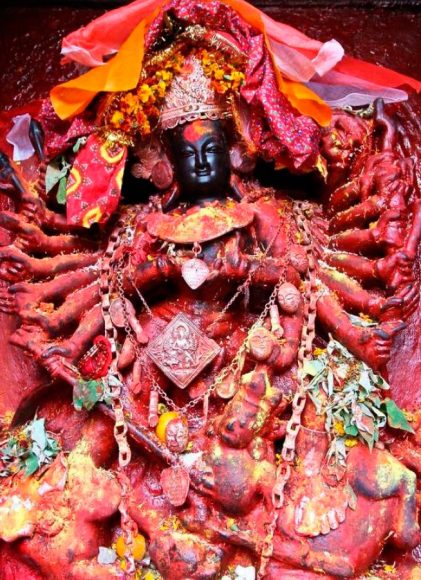
Figure 1. Durga Mahisasuramardini
Demon Mahis.a stands for lust and rage. The Goddess Durgā kills the demon, and so she stands for virtue. The demon also stands for tyranny. The goddess, in slaying the demon, liberates the gods in exile. The demon is often depicted as buffalo-man, with a human head and a buffalo body, and thus reflects the tension between human rationality and animal instincts. As identified above, the demon already is a blend of different inputs, and the image depicting the deity slaying the demon further blends the inputs. The goddess rides on a tiger, which represents valoṛ The Tantric significance goes deeper than this apparent symbolism though. One of the Sanskrit terms for tiger is pañcāsya, or “five-faces”. Most Tantric goddesses are seated atop Sadāśiva, a deity with five faces. In her Durgā iteration, the image of Sadāśiva is substituted with a tigeṛ Sadāśiva is already a philosophically laden concept, with it depicting the harmony of the epistemic modes of awareness reflected within and thus referring to the ego and awareness facing outward, with the other coming to the realm of awareness. The goddess has eighteen arms, while there are many other images with different number of arms. She carries weapons in each of her arms and these weapons are borrowed from different gods. These weapons metonomically represent those gods. The goddess herself is an integral force of all the male gods, as the Devīmāhātmya suggests. Gods, defeated by the demon and unable to defeat with their distributed force, concentrate their energy in a single focal point and the goddess Durgā emerges as the distilled energy of this burning flame of poweṛ She therefore stands for the unity of all powers, and the goddess describes the whole as well as its components. Each of the deities that offered weapons to the goddess in themselves borrow multiple nuances from the Vedic and Tantric symbolism and each therefore already represents a mega-blend. The image of Durgā, however, is not one of the most complex images in Tantras.
Notes
(1) 1 Some scholars have found this position problematic. For discussion, see Ruiz de Mendoza Ibáñez, F.J. and L. Pérez Hernández ([20], pp. 321–57).
(2) 2 One of the most cited examples of mirror networks is the riddle of the monk occupying a place in the path at the same hour of two different days, where he climbs the mountain one day and climbs back the other day [26].
To be continued…
The paper was first published in the Special Issue Cognitive Science and the Study of Yoga and Tantra (Nov 2016) and has been republished with the author’s permission.
Image credit: Wikipedia
(This article was published by IndiaFacts in 2018)
Disclaimer: The opinions expressed in this article belong to the author. Indic Today is neither responsible nor liable for the accuracy, completeness, suitability, or validity of any information in the article.

